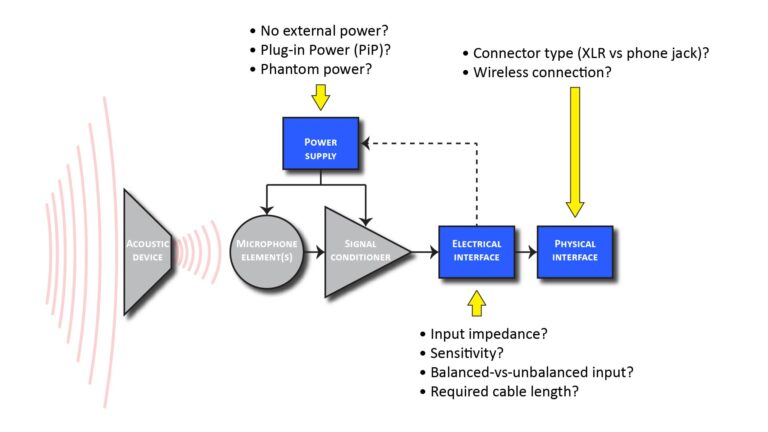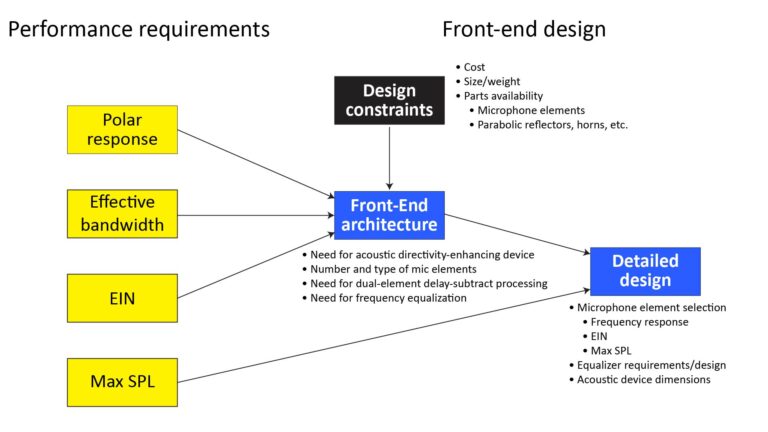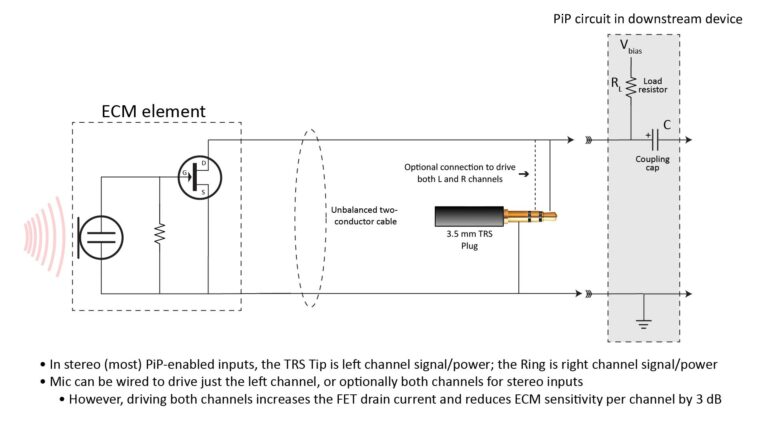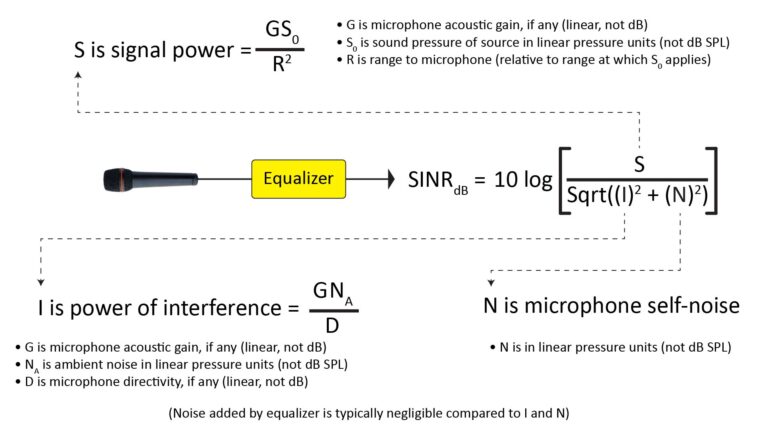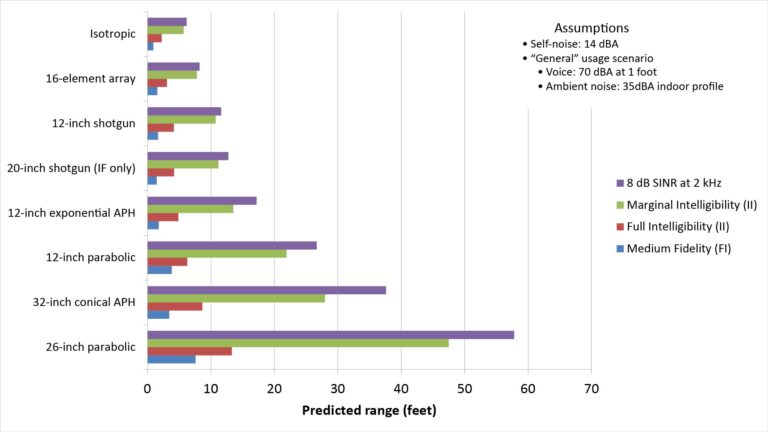What’s the best microphone element for your DIY microphone? Read on for a list of my favorite elements for various DIY microphone applications.
The microphone elements NOT on my list
I don’t build microphones as science projects or as works of art…I build them to actually use them. If I can buy a microphone that does what I want it to do at a reasonable price, there’s no point in trying to build something similar; my time is just too valuable for that.
Therefore, the list of my favorite microphone elements below is based on cost-effectiveness in demanding applications. For that reason,
- I’m excluding microphone elements that cost over $50 or are relatively hard to integrate into a working microphone. This applies to dynamic elements (which are relatively rare in bare-element form and require a quiet, high-gain preamp), as well as externally-polarized condenser microphone elements (good examples of which cost more than $50).
- I’m excluding microphone elements that have an SNR of less than 72dB (or, equivalently, an Effective Input Noise of greater than 22dBA). This applies to the large-diameter electret microphone elements offered by Transound (manufactured by JLI Electronics, Inc.) and often used by DIY microphone builders.
- Finally, I’m excluding microphone elements with digital outputs because they’re a bit harder to use (although I do have some posts in the pipeline on DIY microphones using such elements).
The dynamic and expensive large-diameter capacitive elements I’m excluding do have one performance advantage over the elements listed below: they’re typically capable of greater dynamic range. However, that advantage is moot in the vast majority of microphone applications.
Why you probably don’t need the dynamic range of a dynamic or large-diameter condenser microphone element
A microphone’s dynamic range is the difference between the maximum distortion-free Sound-Pressure Level (SPL) it can handle and the minimum SPL it can capture (which is effectively its self-noise, more precisely known as the Equivalent Input Noise or EIN). Thus:
- If you need to capture extremely loud sounds (such as the sound of a trumpet or a full-throated vocal performance) at very close range (such as within a few inches), then you need a high maximum SPL.
- If you’ll be using the microphone in an extremely quiet environment, like a recording studio, then you need a low EIN.
- But unless you need to do both of the above with the same microphone, you don’t need a high dynamic range.
Here’s the bottom-line: if you’re not recording live music in a professional studio, then it’s unlikely that you need the high dynamic range of a dynamic or externally-polarized condenser microphone element.
And even if you do, there are cost-effective ways to achieve a comparable dynamic range with the microphone elements listed in this post.
There is really only one situation in which a DIY microphone using one of the elements listed on this page might not have a huge cost-effectiveness advantage over an off-the-shelf microphone: when an extremely high dynamic range is needed with a unidirectional polar pattern.
You *can* build such a microphone, but depending on how much you value your time, it might be better to buy an off-the-shelf microphone like the Rode NT1 or the Lewitt LCT 440 Pure (both about $270). Both of those microphones provide a cardioid polar pattern and more than enough dynamic range for any conceivable application. However, I do have a post in the works on a DIY microphone that can rival the performance of those mics for a fraction of the cost…stay tuned!
The characteristics that are important for a good DIY microphone element
Check out my post on the 4 key microphone specs if you want a deep-dive on the most important performance specifications for a microphone and how they should be chosen based on the intended application, but here’s a brief summary:
- The Effective Input Noise (EIN) should be low enough to be inaudible in the intended application.
- The maximum distortion-free SPL should be high enough to handle the loudest expected sounds.
- The polar pattern should be optimized for the expected ambient noise level.
- The frequency response should be wide enough to capture most of the signal bandwidth, although it doesn’t need to be very flat.
I’ll go into EIN, max SPL, and polar pattern a bit more later in this post, but at this point it’s worth elaborating a bit more on frequency response.
Why a flat frequency response is overrated
I discuss microphone frequency response in detail in my aforementioned post on the 4 key microphone specs, but here are the salient points for purposes of this post:
- The gold-standard frequency response of “20 Hz to 20 kHz within 3 dB” is nice to have, but isn’t necessary for excellent performance…and can actually force compromise in other more important performance characteristics.
- One reason a flat response isn’t necessary is that, with downstream equalization, a response variation of as much as 24dB across the signal bandwidth can often be compensated without noticeably degrading the output quality. However, there are two caveats:
- The response variation must be reasonably gradual. For example, 6dB per octave roll-offs are easy to equalize without audible degradation, whereas 24dB per octave slopes (or sharp resonances) aren’t.
- The microphone EIN must be relatively low because any positive equalization will amplify the microphone’s self-noise (and, of course, the equalizer itself must be quiet).
- In fact, downstream equalization is often applied anyway—regardless of the original frequency response—to achieve a desired sonic character.
- Many microphone applications don’t need the full 20 Hz to 20 kHz audio bandwidth. Specifically, very good fidelity can be obtained in many applications with a response that extends from about 120 Hz to 11 kHz.
For these reasons, I don’t consider a wide, flat frequency response to be as important as the other three performance characteristics (EIN, max SPL, and polar response).
Instead, my frequency-response criterion for microphone element selection is that the response should be flat to within 12 dB over the full audio bandwidth. With one exception, all of the elements I describe below easily meet this requirement…and the lone exception still offers enough bandwidth for high-quality voice.
The 7 best microphone elements for the DIY microphone builder
With that introduction out of the way, the following table lists my top 7 microphone elements for cost-effective DIY microphones.
| Microphone element (with external links to datasheets) | Type | Polar Pattern | EIN (dBA) | Max SPL (dB SPL) | Price | Notes |
| Infineon Technologies IM73A135V01XTSA1 | MEMS with SMD packaging | Isotropic | 21 | 133@1% THD | $2.60 | Excellent max SPL; SMD packaging great for array microphones; incredibly small for such a high-performance element |
| BeStar Technologies, Inc. HBO0603B-52/1338 | ECM with PC-pin termination | Isotropic | 20 | 110@3% THD | $3.50 | PC-pin packaging good for array microphones; MOQ 5 units; can be equalized to 20 kHz |
| PUI Audio, Inc. AOM-5024L-HD-R | ECM with Solder Pad termination | Isotropic | 14 | 110@3% THD | $3.00 | Most cost-effective low-EIN element; HD-R series available in multiple variations |
| Primo EM273 | ECM with Solder Pad termination | Isotropic | 14 | 135@3% THD | $21 | Highest dynamic range for a single reasonably-priced microphone element, but still relatively expensive |
| NAC Holdings Limited UB99452-373J-L01C01-00-0 | ECM with Solder Pad termination | Cardioid | 19 | 110@3% THD | $2.20 | Impressively low EIN for an inexpensive cardioid element, but response specified only between 100 Hz and 10 kHz; spotty availability, 21-day lead time |
| Primo EM282 | ECM with Solder Pad termination | Cardioid | 16 | 136@3% THD | $33 | Highest dynamic range of any reasonably-priced cardioid element, but still relatively expensive |
| Shure CVL (link to spec sheet at bottom of linked page) | Complete lavalier mic with TA4F connector | Cardioid | 22 | 139@3% THD | $41 | Already packaged as a lavalier mic; can easily be adapted for use with connectors other than TA4F; offers a very high max SPL with a decent (but not great) EIN |
Table 1 currently lists only one MEMS element, the Infineon IM73A135V01XTSA1. Until very recently, I would have listed the InvenSense ICS-40730 instead, which was the previous leader in high-performance MEMS microphones…and it’s still a great choice (although a bit more expensive and with a lower maximum SPL level, albeit with greater sensitivity).
Note that the last item in the table, the Shure CVL, is not a bare microphone element but rather a complete lavalier microphone. I included it because it’s not much more expensive than the Primo EM282, and—while noisier—can be easily hacked to work with audio devices that don’t have a mating TA4F connector (stay tuned for an upcoming post on how to do that).
To keep it reasonably simple, Table 1 lists just the most important attributes of each element, but there are other considerations, too:
- Frequency response: except as indicated in the “notes” column, all of the elements listed in Table 1 are capable of being equalized to a response of 20 Hz to 20 kHz. The exception is the NAC Holdings Limited UB99452-373J-L01C01-00-0, which is specified only up to 10 kHz; however, it appears to have a usable post-equalization response up to at least 13 kHz.
- The sensitivity of the elements listed in Table 1 varies from -41 to -24 dBV/Pa. These sensitivities are all high enough for use with most audio devices, although a simple preamp might be required in some cases.
- Size: all of the elements listed in Table 1 are small by microphone-element standards, and small enough for most DIY microphone applications. However, where small size is paramount, the Infineon IM73A135V01XTSA1 is the clear winner among these elements; it occupies only 4 percent of the volume of the PUI AOM-5024L-HD-R or Primo elements. Unfortunately, the Infineon’s surface-mount packaging might present an obstacle for some DIYers. Alternatively, PUI does offer other elements in their high-performance HD-R line that give up a bit of performance for a smaller size; for example, the TOM-1537L-HD-R is almost as small as the Infineon and has conventional solder-pads…but at the expense of a greater 26 dBA self-noise.
Next, let’s look at the various applications where these microphone elements shine.
The best microphone elements for low ambient-noise environments
The key requirement for a microphone that’s going to be used in a low ambient-noise environment—like a home recording studio—is a low EIN.
As I explain in my post on the 4 key microphone specs, the EIN should be comfortably below the minimum expected ambient noise level; a margin of 6 dB is ample. And because it’s extremely difficult to achieve an ambient noise level lower than about 20 dBA (even in a professional recording studio), an EIN of 14 dBA should be low enough to be inaudible in just about any practical application.
Note that only two of the microphone elements of Table 1 have an EIN as low as 14 dBA. However, that doesn’t mean that the other microphone elements can’t also be used to achieve a 14 dBA EIN; in fact, they can. But in order to do that, multiple elements must be connected in an additive broadside array configuration. Check out my post on how array microphones work for an in-depth discussion of the topic, but here’s all you need to know for now:
- An additive broadside array microphone consists of N microphone elements whose outputs are summed together. The electronic circuitry needed to do this is trivial, so the overall cost is essentially the aggregate cost of the N microphone elements.
- The EIN of the array configuration is then equal to E – log(N), where E is the EIN of each individual element and N is the number of elements.
So, for example, an array of four microphone elements will have an EIN that is log(N), or 6 dB, less than that of each individual element.
Therefore, another way of comparing the microphone elements of Table 1 is to calculate the aggregate element cost for an array configuration that provides an EIN of 14 dBA. The following table shows such aggregate costs (but omits the Shure CVL, since it’s a complete lavalier microphone and therefore not a cost-effective choice for an array mic):
| Element | Polar Pattern | EIN (dBA) | Max SPL (dB SPL) | Price | Number of elements for 14 dBA array EIN | Element cost for 14 dBA EIN |
| Infineon Technologies IM73A135V01XTSA1 | Isotropic | 21 | 133@1% THD | $2.60 | 5 | $13 |
| BeStar Technologies, Inc. HBO0603B-52/1338 | Isotropic | 20 | 110@3% THD | $3.50 | 4 | $14 |
| PUI Audio, Inc. AOM-5024L-HD-R | Isotropic | 14 | 110@3% THD | $3.00 | 1 | $3 |
| Primo EM273 | Isotropic | 14 | 135@3% THD | $21 | 1 | $21 |
| NAC Holdings Limited UB99452-373J-L01C01-00-0 | Cardioid | 19 | 110@3% THD | $2.20 | 3 | $7 |
| Primo EM282 | Cardioid | 16 | 136@3% THD | $33 | 1 (16 dBA is close enough to 14 dBA) | $33 |
The best low-EIN microphone elements when only a moderate maximum SPL is expected
The vast majority of low-ambient noise microphone usage scenarios involve picking-up spoken voice at distances of no less than a few inches (in order to avoid the risk of plosives). Livestreaming, podcasts, video production, and voiceovers all fall into this category.
The maximum expected SPL in such applications is no greater than 110 dB SPL, which is well within the capabilities of all the elements listed in Table 2. By the way, check out this section of my aforementioned post on the 4 key microphone specifications for the maximum SPL you can expect from various sources at various distances.
Note that an insufficient maximum microphone SPL isn’t always the culprit when loud sounds cause severe distortion and clipping; often it’s the downstream electronics that are being overloaded.
The clear winner: the PUI AOM-5024L-HD-R
Therefore, the clear winner in the low-ambient-noise, moderate-maximum SPL category is the PUI AOM-5024L-HD-R. It has an EIN of 14 dBA, a max SPL of 110 dB, and a full 20 Hz to 20 kHz frequency response—for only around $3! That’s an incredible bargain.
This microphone is ideal for DIY lavalier microphones, studio microphones, and even parabolic and shotgun microphones. It’s the most cost-effective all-around microphone element available today.
Further, while it’s small enough (at a diameter of 9.7 mm) for most applications, PUI also offers similar microphones in smaller sizes (albeit with slightly higher EIN), as well as with attached wire leads. The PUI HD-R series is a game-changer for DIY microphone builders.
The next most cost-effective element, the NAC Holdings unit, is a distant second choice because its cardioid pattern is unnecessary in this application (and comes at the expense of a limited high-frequency response), and because an array of 3 units is necessary to achieve the desired EIN.
The best low-EIN microphone elements when a high maximum SPL is expected
Some microphones, and especially dynamic types, have a maximum SPL capacity that exceeds 150 dB SPL (in fact, the Shure SM7B is rated at 180 dB SPL).
However, unless you’re close-miking a trumpet, you almost certainly don’t need a microphone that can handle more than 130 dB SPL. That’s sufficient to handle full-throated vocals at a mic-to-mouth distance of just a couple of inches.
Looking at the isotropic elements of Table 2 that can handle at least 130 dB with an EIN of just 14 dBA, we see just three choices:
- The Infineon IM73A135V01XTSA1 in an array configuration of 5 elements has an aggregate element cost of $13, but requires surface-mount soldering and a bit of additional electronics.
- The Primo EM273 offers an EIN of 14 dBA with just a single element, which costs $21.
- The Primo EM282 offers an EIN of 16 dBA with just a single element, which costs $33. However, its cardioid pattern is unnecessary in this application, so the slightly quieter EM282 is the more cost-effective choice.
Both the Infineon and Primo EM273 have a broad frequency response and similar sensitivities that are on the low side (the Infineon is -38 dBV while the Primo is -37 dBV). Thus, they could both benefit from a little preamplification in the microphone itself, although that’s not necessary when used with a device that has a high-gain preamp (such as a high-quality field recorder or audio interface).
The choice between the Infineon and the Primo is a toss-up:
- The Infineon is obviously more cost-effective if you’re familiar with electronics and surface-mount soldering. The need for an array configuration and a summing amplifier is a disadvantage, but summing amplifier could also be easily configured to provide enough gain to drive even low-sensitivity audio inputs.
- On the other hand, if you don’t want to bother with surface-mount soldering and you’re going to use your DIY microphone with a device that has a reasonably high-gain preamp, then the Primo 273 is a great choice and makes for a much easier easy build. Of course, a preamp can easily be added if necessary, but that lessens its advantage over the Infineon in terms of simplicity.
The best microphone elements for high ambient-noise environments
Many microphone use-cases don’t have the luxury of a low-noise studio environment. The expectation of high ambient noise has two implications for microphone element selection:
- A low EIN isn’t necessary because the overall noise at the microphone output will be dominated by ambient noise.
- A directional polar pattern is necessary (or at least highly desirable), because that’s the only microphone attribute that can suppress ambient noise.
The most straightforward way to achieve a directional microphone pattern is to use a microphone element that has a directional polar pattern. However, that’s not the only way: multiple microphone elements can also be connected in a differential array configuration to synthesize a directional pattern.
The simplest approach: using a single microphone element with a directional polar pattern
If we want the simplest possible implementation of a DIY microphone for a high ambient-noise environment, we need a microphone element that has a directional polar pattern. In that case, we can exclude all the elements of Table 1 that have isotropic patterns…which leaves just three microphone elements:
| Element | Termination | Polar Pattern | EIN (dBA) | Max SPL (dB SPL) | Price | Notes |
| NAC Holdings Limited UB99452-373J-L01C01-00-0 | Solder Pads | Cardioid | 19 | 110@3% THD | $2.20 | Most cost-effective choice by far when only moderate maximum SPL is expected |
| Primo EM282 | Solder Pads | Cardioid | 16 | 136@3% THD | $33 | Most cost-effective choice when higher maximum SPL is expected |
| Shure CVL | Wired | Cardioid | 22 | 139@3% THD | $41 | Less cost-effective than other choices, but already comes packaged as a complete lavalier microphone |
The NAC element is obviously the most cost-effective choice when a high maximum SPL isn’t needed. Its high-frequency response is a bit limited, but that won’t be noticeable in a high ambient-noise environment. This is a great element for a lavalier microphone intended for use in such an environment.
If you do need a high maximum SPL, you’ll have to spend a lot more for either the EM282 or the CVL. The Primo EM282 is more flexible than the CVL (because its relatively low EIN also allows it to be used in quieter environments), but the CVL has the convenience of already being packaged as a lavalier mic. If you’re looking for a good DIY cardioid lav that requires a minimum of work, then adapting the CVL’s TA4F connector to something more useful might be the best route (I have a post on that in the works).
Another approach to obtaining a cardioid pattern: the differential array configuration
There are many ways to obtain a directional polar pattern with a microphone. However, every directional microphone that’s smaller than a shotgun or parabolic microphone operates as a differential end-fire array: its output signal is equal to the difference between the sound pressure on one side of the microphone and the time-delayed sound pressure on the other side of the microphone.
Microphone elements that have a cardioid pattern do this acoustically, via a sound port and acoustic delay-network on the back-side of the diaphragm.
However, it can also be done electronically using two isotropic microphone elements, an electronic time-delay, and a differential amplifier. In fact, my aforementioned post on how array microphones work has an in-depth discussion on differential end-fire arrays and the functional equivalence between them and conventional studio microphones. This electronic approach has two major advantages: it allows the use of higher-performing isotropic microphone elements, and it enables the polar pattern to be electronically switched between isotropic, unidirectional, and bidirectional. All modern studio microphones with switchable polar patterns work this way.
The design of a unidirectional microphone based on the differential array principle is beyond the scope of this post. However, I cover the theory in detail in my aforementioned post on how array microphones work, and I have several posts in the works on DIY microphones using this principle.
Wrap-up
There are hundreds of microphone elements on the market, but the seven I’ve listed in this post are the
“cream of the current crop” for the DIY microphone builder.
However, the two market leaders in cost-effective high-performance microphone elements—PUI Audio, Inc and Primo—do offer other microphone elements not listed in this post that could be better choices in certain specialized applications.
For example, I haven’t explicitly addressed element size in this post, and while all the elements I’ve listed are fairly small, PUI does offer other elements in their high-performance HD-R series that are smaller than the 9.7-mm diameter AOM-5024L-HD-R I’ve chosen. In general, dynamic range decreases with diaphragm size, but it you want to build the smallest possible microphone, then it might be worth checking-out something like PUI’s TOM-1537L-HD-R (which has a diameter of just 4mm, but a significantly higher EIN of 26 dBA).
Resources
- PUI offers a lot of microphone elements, and their part-numbering convention can be confusing. Here’s a useful guide: https://puiaudio.com/wp-content/uploads/2022/08/PartNumberingforMicrophones.pdf
- PUI also has some other useful resources for the DIY microphone builder at https://puiaudio.com/learn/resources/.
- PUI microphone elements are available from all major electronics distributors, but I use Digi-Key: https://www.digikey.com/.
- Primo elements aren’t as widely distributed; the sole source is Micbooster: https://micbooster.com/
- Micbooster provides an extremely useful comparison table of the various Primo elements at https://micbooster.com/content/12-comparison-table-for-primo-microphone-capsules.
- Currently, my list of favorite elements includes only one MEMS microphone—the Infineon Technologies IM73A135V01XTSA1—which I consider to be the current best MEMS option for a DIY microphone. One of the advantage of a MEMS microphone is that their datasheets are far more informative than those of ordinary ECM elements; check out the IM73A135V01XTSA1’s datasheet to see what I mean.
- As I mentioned earlier in the post, an excellent alternative to the Infineon MEMS element I’ve listed is the InvenSense ICS-40730, which is a bit more expensive ($3.70) and has a lower maximum SPL but greater sensitivity. In addition to a comprehensive datasheet, InvenSense also provides a series of Application Notes that are extremely useful for the DIY microphone builder at https://invensense.tdk.com/products/analog/ics-40730/.

